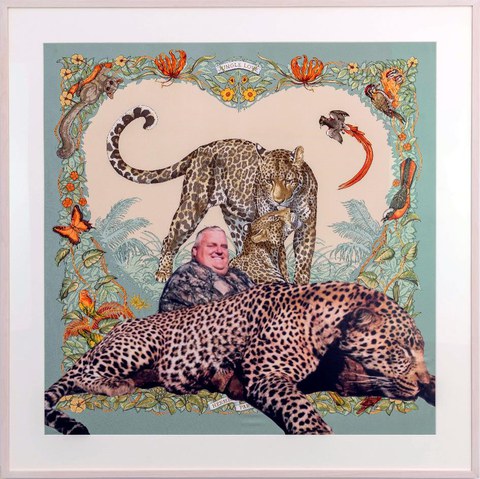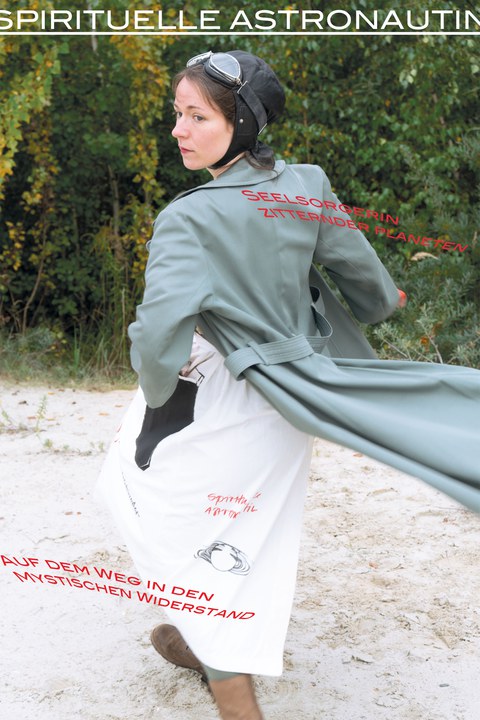Ausstellungsreihe im Kabinett: Sophie Lindner, NEOZOON, Andrea Grützner
Inhaltsverzeichnis
„Dieses ist das Bild der Welt, Die man für die beste hält“. Eine Ausstellungsreihe im Kabinett der Universitätsgalerie zum Thema Art & Science der Kustodie in Kooperation mit den Lehr- und Forschungssammlungen der TUD
Mai 2025 bis Juli 2026
Galerie der Kustodie im Görges-Bau, TUD
Kuratorisches Team: Gwendolin Kremer, Andreas Kempe
Unter dem Titel „Dieses ist das Bild der Welt, Die man für die beste hält“ (frei nach Johann Wolfgang von Goethe) zeigt die Kustodie der TUD im Kabinett der Galerie der Kustodie im Görges-Bau auf zwei Etagen zeitgenössische Positionen von der Installations- und Performancekünstlerin Sophie Lindner (Mai bis November 2025), dem Filmemacherinnen-Kollektiv NEOZOON (November 2025 bis März 2026) und der Fotografin Andrea Grützner (März bis Juli 2026) im Dialog mit wissenschaftlichen Lehr- und Forschungsobjekten aus den universitären Sammlungen.
Das Potenzial künstlerischer Forschung für die Erschließung und Sichtbarmachung von universitären Lehr- und Forschungssammlungen konnte in den vergangenen fünfzehn Jahren in wissenschaftlichen Vorhaben und Ausstellungsprojekten dargelegt werden. Am Beispiel der an der Kustodie angedockten Artist in Residence-Programme wie dem Schaufler Lab@TU Dresden zu Künstlicher Intelligenz und Daten-Welten oder dem S+T+ARTS Ec(h)o-Programm sowie durchgeführten Ausstellungsprojekten wird offensichtlich, wie mit künstlerischen Mitteln wissenschaftliche Themenstellungen vor der Folie von Lehr- und Forschungsobjekten hinterfragt, kontextualisiert und im besten Fall um Erkenntnisgewinne erweitert werden. Künstlerisch-spekulative Forschung kann den lernenden und prozesshaften Charakter von Wissenschaft exemplarisch an historischem Sammlungsgut erfahrbar machen. Auf den ersten Blick haben die übergeordneten Themensetzungen der bei uns angedockten Residencies keinen Bezug zu den universitären Sammlungen. Sie verweisen vielmehr in die Informatik, in die Ingenieur- und Naturwissenschaften – flankiert von den wesentlichen kleineren Geistes- und Sozialwissenschaften bei uns in Dresden.
Die Vermutung liegt also nahe, dass die sich bewerbenden Künstler:innen vor allem an High Performance Computing und außergewöhnlichen Visualisierungspraxen interessiert sind, die sich vorrangig im Digitalen abspielen. Weit gefehlt! Unsere Erfahrung der vergangenen acht Jahre hat gezeigt, dass es gerade die Objekte aus den vielfältigen und hochkarätigen Sammlungen sind, welche die Künstler:innen begeistern und helfen, ihre Forschungsideen zu konkretisieren. Dabei sind die Sammlungsobjekte nicht einfach nur ein Vehikel, sondern in der Regel zentraler Forschungsgegenstand. Als materialisierte Wissenskörper dienen die Lehrobjekte dazu, Zukunftsforschung in eine Wissensgeschichte einzubetten und gleichwohl als eigenständiges künstlerisches Werk auch eine Vermittlungsfunktion zu übernehmen.
Wissenschaftliches Wissen erfährt in den vergangenen fünfzehn Jahren eine gesteigerte Aufmerksamkeit in der Öffentlichkeit, wenn politische Akteure Forschung, Expertise und Handlungsempfehlungen von der Wissenschaft ab- und einfordern oder gar in dieses Feld eingreifen. Universitäten und damit auch Universitätssammlungen sowie Kustodien sind hierbei extrem gefordert; im Zentrum steht die glaubhafte und nachvollziehbare Vermittlung wissenschaftlicher Fragestellungen, von Erkenntnissen und Debatten in die breite Gesellschaft. Der Rückgriff beziehungsweise die Aktivierung der Lehrobjekte im Kontext von künstlerischen Forschungsprogrammen wie bei uns an der Kustodie können folglich einen substantiellen Beitrag zur Etablierung der universitären Sammlungen als Forschungsinfrastruktur leisten.
So hat uns auch Gerfried Stocker, künstlerischer Geschäftsführer der Ars Electronica und Beiratsmitglied im Schaufler Lab@TU Dresden, bescheinigt, dass es gerade die Sammlungen unserer Universität sind, die uns ein Alleinstellungsmerkmal im Kontext wissenschaftlicher und transdisziplinärer Programme auf internationalem Niveau garantiert.
#1 Sophie Lindner: Celestial Classrooms – Sternwarten und das Planetarische
Mit Fotografien aus der Hermann-Krone-Sammlung des Instituts für Angewandte Physik (IAP) und Objekten aus der Astronomisch-Geodätischen Sammlung sowie der Kartographischen Sammlung, TUD
19. Mai bis 14. November 2025
Den Auftakt der Kabinettreihe macht die in Leipzig lebende Installations- und Performancekünstlerin Sophie Lindner. Fotografien, Zeichnungen, Objekte der Künstlerin sowie von ihr zusammengetragene Archivmaterialien aus ostdeutschen Sternwarten werden neben experimentellen Aufnahmen des Fotopioniers Hermann Krone und Objekten aus der Astronomisch-Geodätischen Sammlung sowie der Kartographischen Sammlung in einem installativen Arrangement präsentiert. Das materielle Erbe der Sternwarten in der DDR, die für einen ganz eigenen Kosmos von Wissensgeschichte und Gesellschaftspolitik im 20. Jahrhundert stehen, bindet Sophie Lindner bewusst in ihre Installationen ein, um geschichtliche Zusammenhänge von Transformation und Wissenstransfer deutlich zu machen.
Im Zentrum von Lindners „Environment Sternwarte“ steht die Frage nach dem Verhältnis von Mensch und Kosmos im Kontext von Wissenschaft und Kunst. Zur Diskussion gestellt werden künstlerisch-spekulative Aneignungspraxen von Weltbildern und Paradigmen für eine neu gedachte Planet-Mensch-Beziehung im Zeitalter des Anthropozäns. Die von ihr entwickelten Kunstfiguren wie die „Spirituelle Astronautin“ oder die „Planetary Nurses“ sorgen sich um das Wohlergehen planetarer Beziehungen, wenn sie versuchen, die Interaktion und Bezüglichkeit von Mensch und Erde in all ihren Ausprägungen sicht- und erlebbar zu machen. Als Stellvertreter:innen bzw. Repräsentant:innen einer neuen wissenden Entität pflanzen sie Obstbäume oder halten Ausschau nach dem Planetarischen. Letztlich versteht Sophie Lindner ihre künstlerische Praxis als Fortführung von Konzepten des Kosmologischen, die sie anekdotisch und poetisch in Objekt-Arrangements und performative Partizipationsformate überführt.
Die Faszination für den Planeten Erde und den Weltraum ist uralt. Schon in der Vorantike spielte die Kosmologie eine zentrale Rolle, um den eigenen Lebensraum und das Universum besser zu verstehen. Die Objekte und Lehrtafeln aus der Astronomisch-Geodätischen Sammlung, der Kartographischen Sammlung sowie der Hermann-Krone-Sammlung geben einen kleinen Einblick in die in der Wissenschaft und (akademischen) Ausbildung eingesetzten Instrumente und Materialien. Die Lehrobjekte dienten allerdings vorrangig dazu, dem Menschen den Kosmos zu erschließen und zielten nicht darauf ab, ein relationales Verhältnis im Sinne von „planetarisch denken“ (Claus Leggewie) abzubilden.
Sophie Lindner (*1990 in Jena, lebt und arbeitet in Leipzig) studierte von 2011 bis 2017 an der Hochschule für Bildende Künste (HfBK) Dresden in der Fachklasse von Prof. Ulrike Grossarth und absolviert seit 2024 ihr Meisterschülerstudium bei Prof. Stefanie Wenner. Lindner ist Mitglied des Kollektivs CindyCat, einer freien Gewerkschaft von Kulturarbeiter:innen (https://cindycat.net). Aktuell wirkt sie als künstlerische Dozentin an der HfBK Dresden. Ihre Werke wurden in zahlreichen Ausstellungen gezeigt und im Rahmen von Lecture-Performances aufgeführt; sie erhielt mehrere Förderpreise, unter anderem von der Liebelt-Stiftung Hamburg.
Weitere Informationen zur Austellung und zum Begleitprogramm finden Sie im Faltblatt hier.
#2 NEOZOON: PROBE
Mit Lehrobjekten aus der Zoologischen Lehrsammlung der TUD
5. Dezember 2025 bis 29. Januar 2026
Mit dem Künstlerinnenkollektiv NEOZOON gehen wir in die zweite Runde der Kabinettausstellungsreihe. Die Ausstellung PROBE entsteht im Dialog mit der Zoologischen Lehrsammlung der TUD , in der ein neues Custer zu vom deutschen Zoll beschlagnahmten Exponaten wie unter das Artenschutzgesetzt fallende (exotische) Tiere, deren Felle, Zähne, Federn, sowie weiteren Präparaten entsteht, die der Universität als Dauerleihgaben für Lehrzwecke überlassen werden.
„Probe“ meint Versuch, Prüfung und Stichprobe zugleich. Unter diesem doppeldeutigen Vorzeichen nehmen NEOZOON Objekte in den Blick, die zwischen Trophäe, Kontrabande, Beweisstück und Lehrmittel changieren: vom Zoll beschlagnahmte Artefakte, deren Zirkulation an den Schnittstellen von Begehren, Verbot und Wissensordnung unterbrochen wurde. In diesen „Proben“ materialisieren sich Rechts- und Kontrollregime des Artenschutzes ebenso wie globalisierte Warenketten und ihre Bildpolitiken.
In unserer Ausstellung PROBE beziehen sie sich auf zollamtlich konfiszierte Naturalia als „Objekte zweiter Ordnung“: Gemeint sind damit „Dinge“, deren primäre Referenz, also das unmittelbare Verweisen auf das Tier und seinen Lebensraum, von einer sekundären Bedeutungs- oder Zuschreibungsebene überlagert wird. Diese Objekte fungieren als Asservate gesellschaftlicher Operationen und Infrastrukturen wie Handel, Recht, Zoll, Sammlung oder Medien und dokumentieren weniger „Natur“ selbst als die Bedingungen ihrer Sichtbarmachung. Der Blick verschiebt sich damit von der Sache zum System, das die Sache hervorbringt, zirkulieren lässt, reglementiert und ausstellt.
PROBE ist folglich eine Beobachtung der Beobachtung. Die Ausstellung legt die Logiken von Kontrolle und Medialisierung offen und bindet die Praxis des Kollektivs eng an den Gegenstand im forschenden Umgang mit vorgefundenem Material sowie einem analytischen und zugleich ironischen Blick.
Das Künstlerinnenkollektiv NEOZOON wurde 2009 in Berlin/Paris gegründet. In Filmen und installativen Videoarbeiten operieren die Künstlerinnen mit Collage, Found Footage und Montagen. Ihre Arbeiten hinterfragen die Ikonografie des Speziesismus und legen jene Ambivalenzen frei, in denen nicht-menschliche Lebewesen als Ressource, Projektionsfläche und Rechtsobjekt zugleich erscheinen.

NEOZOON: Carré Jungle Love (ab 2017)
#3 Andrea Grützner
Mit Artefakten aus dem Herbarium Dresdense und der Sammlung Bodenkunde der TUD
In Kooperation mit bautzner69/publish & print Raum + Verlag
März bis Juli 2026

